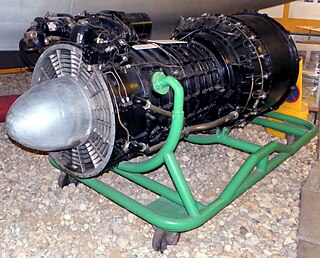Related Research Articles

The Junkers Jumo 004 was the world's first production turbojet engine in operational use, and the first successful axial compressor turbojet engine. Some 8,000 units were manufactured by Junkers in Germany late in World War II, powering the Messerschmitt Me 262 fighter and the Arado Ar 234 reconnaissance/bomber, along with prototypes, including the Horten Ho 229. Variants and copies of the engine were produced in Eastern Europe and the USSR for several years following the end of WWII.

The Lyulka AL-21 is an axial flow turbojet engine created by the Soviet Design Bureau named for its chief designer Arkhip Lyulka.

The Metropolitan-Vickers F.2 is an early turbojet engine and the first British design to be based on an axial-flow compressor. It was an extremely advanced design for the era, using a nine-stage axial compressor, annular combustor, and a two-stage turbine.
The Tumansky R-13 is a Soviet turbojet engine designed by Sergei Alekseevich Gavrilov.

The Lyulka AL-7 was a turbojet designed by Arkhip Mikhailovich Lyulka and produced by his Lyulka design bureau. The engine was produced between 1954 and 1970.

The Klimov RD-500 was an unlicensed Soviet copy of the Rolls-Royce Derwent V turbojet that was sold to the Soviet Union in 1947. The Klimov OKB adapted it for Soviet production methods and materials.

The Heinkel HeS 3(HeS - Heinkel Strahltriebwerke) was the world's first operational jet engine to power an aircraft. Designed by Hans von Ohain while working at Heinkel, the engine first flew as the primary power of the Heinkel He 178, piloted by Erich Warsitz on 27 August 1939. Although successful, the engine had too little thrust to be really useful, and work started on the more powerful Heinkel HeS 8 as their first production design.

The Lotarev DV-2 is a two-spool turbofan engine manufactured in Považská Bystrica, Slovakia by Považské Strojárne Letecké Motory (PSLM) and designed in partnership with Ivchenko Lotarev Design Bureau.
The Avro Canada TR.4 Chinook was Canada's first turbojet engine, designed by Turbo Research and manufactured by A.V. Roe Canada Ltd. Named for the warm Chinook wind that blows in the Rocky Mountains, only three Chinooks were built and none were used operationally. The Chinook was nevertheless an extremely successful design in terms of introducing new concepts and materials, and after being scaled up from 2,600 lbf (12 kN) to 6,500 lbf (29 kN), would become the Orenda.

The General Electric YJ93 turbojet engine was designed as the powerplant for both the North American XB-70 Valkyrie bomber and the North American XF-108 Rapier interceptor. The YJ93 was a single-shaft axial-flow turbojet with a variable-stator compressor and a fully variable convergent/divergent exhaust nozzle. The maximum sea-level thrust was 28,800 lbf (128 kN).

The Fairchild J44 was a small turbojet developed in the 1940s by the Fairchild Engine Division.
The Lyulka TR-1 was a turbojet designed by Arkhip Lyulka and produced by his Lyulka design bureau. It was the first indigenous Soviet jet engine.
The Lyulka AL-5 was a Soviet axial compressor turbojet developed from the Lyulka TR-3 turbojet around 1950. It was flight-tested in a number of prototype aircraft, but was not accepted for production.

The PZL Rzeszów SO-1 and PZL Rzeszów SO-3 are Polish turbojet engines designed by the Instytut Lotnictwa and manufactured by WSK PZL Rzeszów, to power the PZL TS-11 Iskra jet trainer. Thirty SO-1s were built, this being superseded by the improved SO-3, of which a further 580 were built. The engine has a seven-stage compressor, annular combustion chambers, and a single-stage turbine.
The Flader J55, also known as the 124 within the company, was a small turbojet engine notable for its use of a supersonic axial-flow compressor. Development started at Fredric Flader Inc. in 1947, with the first examples being delivered in 1949. However, these delivered far lower power than predicted. Improved models followed in early 1952 that met the performance requirements, but demonstrated very poor reliability. When small engines from other companies became available, the J55 project was cancelled in 1952.
The Packard XJ49 was the first U.S. designed turbofan aircraft engine, and was developed by the Packard Motor Co. in the 1940s.
The Packard XJ41 was a turbojet aircraft engine developed by the Packard in the mid-1940s.
The Turbomeca Piméné was a small French turbojet engine produced by Turbomeca in the early 1950s.
The Turbomeca Orédon was a small French turbo-shaft / Auxiliary Power Unit (APU) engine produced by Turbomeca in the late 1940s.
The Klimov VK-3 was the first Soviet afterburning bypass turbojet engine. Designed by S V Lyunevich at Klimov, at OKB-117 in 1949, this engine first ran in 1952, and was qualified at 5,730 kg (12,632 lb) thrust (dry) and 8,440 kg (18,607 lb) thrust in 1954. The VK-3 was developed for the Mikoyan-Gurevich I-3 (I-380) and I-3U/I-5 (I-410) fighters. First flown in the I-3U in July 1956, the engine's performances was good but its reliability was poor. Even after modifications in December 1956 when newly designed compressor blades were installed, developmental problems continued, the program was ultimately canceled in January 1958. The engine was superseded by the Lyulka AL-7F, a less modern but more efficient engine.
References
- Notes
- ↑ Kay, pp. 27–28
- Bibliography
- Kay, Anthony L. Turbojet: History and Development 1930–1960: Volume 2: USSR, USA, Japan, France, Canada, Sweden, Switzerland, Italy, Czechoslovakia and Hungary. Marlborough, Wiltshire: Crowood Press, 2007 ISBN 978-1-86126-939-3
- Gunston, Bill. The Osprey Encyclopaedia of Russian Aircraft 1875–1995. London, Osprey, 1995 ISBN 1-85532-405-9